
This page is part of © FOTW Flags Of The World website
Dictionary of Vexillology: Appendix VIII
Crosses in Heraldry
Last modified: 2010-01-02 by phil nelson
Keywords: vexillological terms |
Links: FOTW homepage |
search |
disclaimer and copyright |
write us |
mirrors
On this page:
The following terms may be encountered when referring to a cross in a flag,
or banner of arms, or heraldic flag of some other description.
Cross Botonny (or Bottonny or Bottonnée)
The heraldic term for a cross that does not usually extend to the edges of a shield, flag, canton or panel,
but whose ends are formed by three discs – a trefoil or treflee cross (see also
‘cross 2)’,
‘disc’ and
‘trefoil’).



From left: Example; Flag of the Order of St Maurice, Italy (fotw); Flag of Massonnens, Switzerland (fotw)
Cross-Cantonée (or Cantoned)
The heraldic term for a cross which may or may not extend to the edges of a shield, flag, canton or panel,
but which has four further crosses (or other charges) arranged around it – a cross cantoned
(see also ‘canton 3)’, ‘cross 1)’,
‘cross pattée’ and ‘cross potent’)




From left: Crosses-Cantonée examples; The Kingdom of Jerusalem c1200 (CS); National Flag of Georgia (fotw)
Please note as may be seen in the illustrations above, various types of cross can be used to
make up a cross cantonée, and that a Jerusalem Cross (constructed of a cross-potent and four Greek crosses or of five
crosses-potent) is one specific type.
Cross-clechée
Cross-Counterchanged
The heraldic term for a cross that extends to the edges of a shield, panel, banner of arms or flag, and which
is divided along its horizontal and vertical centre-line with the tinctures of the field and cross alternating
in adjacent quarters (see also
‘counterchanged’,
‘cross 2)’,
‘quarter 2)’ and
‘tincture’).
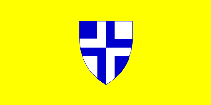

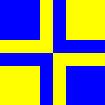
Flag and Arms of Zapresic, Croatia (fotw); Flag of Kreis, Switzerland (fotw)
Please note that a cross that is divided only along either its horizontal or
vertical centre-line is properly blazoned using a full description – for example, “per fess argent and azure
a cross-couped counterchanged" or “per pale argent and gules a Maltese Cross counterchanged” as shown below.
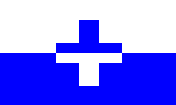

Flag of Zurrieq, Malta (fotw): Flag of Villars-Saint-Croix, Switzerland (fotw)
Cross-Couped
A heraldic term sometimes used when a cross (either plain or decorated) does not extend to edges of a shield,
banner of arms or flag (see also ‘couped 2)’ and ‘Greek cross 2)’).
Please note that, unless referring to a plain cross, this term is always
accompanied by a further description, for example a “cross botonny couped”.
Cross Crosslet
The heraldic term for a cross which does not usually extend to the edges of a shield, flag canton or panel,
but whose arms have a short transverse bar inserted (see also ‘cross 2)’).


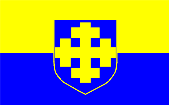
Flag of Echt-Susteren, The Netherlands (fotw); Flag of Slupca, Poland (Jarig Bakker)
Cross-Fitchy
The heraldic term for a cross which does not usually extend to the edges of a shield, flag, canton or panel,
and which may have plain or decorated ends, but whose vertical arm comes to a point at its base (see also
‘cross 2)’ and ‘cross of Santiago’).


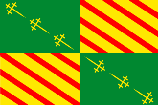

Flag of Bernissart, Belgium (fotw); Flag of Avinyó, Spain (fotw)
Please note that, unless referring to a plain cross, this term is always accompanied
by a further description, for example a “cross crosslet fitchy”.
Cross Fleury (or Flory, Floretty or Fleuronny)
Cross Moline
The heraldic term for a cross which does not usually extend to the edges of a shield, flag, canton or panel,
but whose ends are split into two curved pieces (see also ‘cross 2)’).


Flag of Annœullin, France (fotw)
Cross of Calvary (or Cross of Crucifixion)
The heraldic term for a cross that does not usually (although it may) extend to the edges of a shield,
flag, panel or flag, but which is mounted on three steps.



From left: Example; Flag of Geraardsbergen, Belgium (fotw); Flag of Fulleda. Spain (fotw)
Cross of Santiago
Cross Pattée (or Patée, Patty or Paty)
The heraldic term for a cross which may or may not extend to the outer edges of a shield, flag, canton
or panel, whose arms are generally flat-ended but which is wider at its outer ends than it is in the centre.
The arms can be straight-sided or curved throughout their length, or they can be straight-sided and parallel
until being flared at their outer end – a cross formée, formé or formy, or an
iron, Hanseatic, Hansa, cavalier or cavalier’s cross –
but see ‘Maltese cross’ (also ‘cross 2)’).

![[Wallis & Futuna]](../images/v/vxt-d592.gif)
![[Guernsey civil ensign]](../images/v/vxt-d592a.gif)
![[Cr. Jensen houseflag]](../images/v/vxt-d592b.gif)
From left: example; Flag of Wallis & Fortuna; Civil Ensign of Guernsey; House flag of Chr. Jensen, Denmark (fotw)
Cross Potent (or Potence)
The heraldic term for a cross which does not usually extend to the edges of a shield, flag, canton or panel,
but whose arms terminate in a transverse bar – a cross potence or Teutonic
Cross (see also
‘cross 2)’ and ‘cross-cantonée’).


From left: Cross-Potent example; Flag of Goumoëns-la-Ville, Switzerland (fotw))
Cross Tau
Cross-Voided
The heraldic term for a cross that may or may not reach the edges of a shield, banner of arms or flag and
may be either closed or open-ended, but from which the centre is removed so that the field may be seen through it
(see also ‘voided’)



From left: example; Flag of the Mouvement Normand, France (fotw); Flag of De Haan, Belgium (fotw)
Please note that, unless referring to a plain cross, this term is always accompanied
by a further description, for example "a cross pattée voided".
Latin Cross
The heraldic term for a cross that does not extend to the edges of a shield, flag, panel or flag, but whose
horizontal arm is shorter than its vertical and which is set above the centre line – a long cross (see also
‘Greek cross’ and ‘cross 2)’)




From left: example; Flag and Arms of Budinšcina, Croatia (Fame); Flag of the Muzzle Loaders of Manitoba, Canada
Please note that, unless referring to a plain cross, this term should always
accompanied by a further description, for example a “Latin cross pattée”.

Flag of Urtenen-Schönbühl, Switzerland (fotw)
Introduction | Table of Contents
| Index of Terms | Previous Page | Next Page









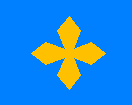




























![[Wallis & Futuna]](../images/v/vxt-d592.gif)
![[Guernsey civil ensign]](../images/v/vxt-d592a.gif)
![[Cr. Jensen houseflag]](../images/v/vxt-d592b.gif)













